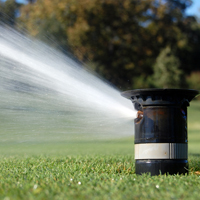One of the most frequently asked questions we hear is, “When is the best time to control weeds in the lawn?” The answer is, “It depends.”
First, we must determine several things:
- Is it a broadleaf weed or grassy weed?
- Is the weed an annual, biennal, or perennial?
Knowing these things will help identify the type of weed you have. Then, our next question is:
- Why is it here?
Weeds Are Very Opportunistic
Generally speaking, weeds grow in areas of turf that are under stress, mowed too short, or in thin and bare areas. Where lawn grasses are not competitive, weeds creep in.
Several practices can be put into play to reduce weed pressure and help restore the lawn to its original beauty. Killing weeds with weed killer is like treating the symptom rather than the disease. That’s why we strive to provide a natural alternative with lawn maintenance focused on cultural practices, not chemicals.
Proper Mowing & Watering
Improper mowing and watering are the primary reasons lawns have weeds. Both cultural practices, if done incorrectly, contribute to heavy weed pressure. A lawn improperly cut weakens the turfgrass roots and may take as long as eight weeks to recover.
For cool season grasses, it is best to cut at 3 ½ inches. Warm season grasses are different and may be cut shorter, generally around 2 inches, during their active growing season. Check out our mowing tips.
Watering should be done deeply and infrequently; a good rule of thumb is 1 hour of watering every week. Lawns watered too frequently or not enough may develop diseases which weakens the lawn causing an increased presence of weeds. Here’s more help with how to tell if your lawn needs to be watered.
Timely Fertilization
Begin with a sound fertilization program by either hiring a lawn care professional, such as NaturaLawn of America, or doing it yourself.
Select the proper fertilizer based on a soil test and the time of the year as every lawn has different needs. Spreaders must be calibrated correctly, otherwise fertilizer may be spread unevenly. Too much fertilizer can harm grass, and too little can be ineffective.
Aeration & Seeding
Weeds can also be reduced through aeration and seeding. Core aeration opens up the soil, pulling up millions of microbes and depositing these little guys on top of the turf. As the soil cores break down, these microbes feed on existing thatch. Removing thatch reduces stress on the lawn because it allows nutrients and water to flow more freely to the roots.
Aeration also reduces compaction, making it easier for turfgrass to breathe and allowing new seed to grow in its place. A thick strand of grass helps “choke out” weeds.
When Should I Control Weeds?
To survive, weeds require favorable conditions. Unfortunately, weeds are everywhere and can survive in nearly any environment. This means in order to control weeds best, a healthy environment is needed so that turfgrass can crowd them out naturally.
Continual upkeep is important for weed control. If you need assistance with helping your turfgrass thrive, please get in touch with your local NaturaLawn of America office today.










